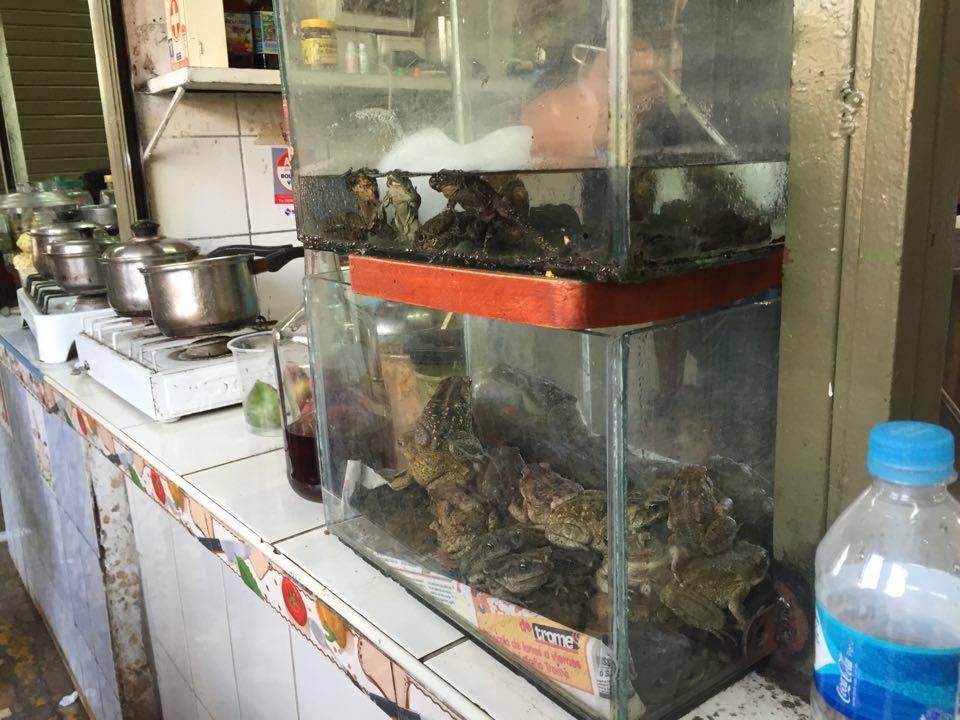
It was an old recipe that her mother had made for curing anemia and headaches.
By Michelle Santos
[divider]
When fellow Globalist trip member Elizabeth Miles mentioned a witch market in Lima, Peru that sold Jugo de la Rana (frog drink), I was the first to say I wanted to go. I’ve eaten guinea pig in the past, and this was the perfect opportunity to try another seemingly bizarre delicacy. Leaving our hostel in Miraflores, our group hustled to a bus, then a train, and finally el Mercado de las Brujas (the witch market) located just beneath the Gamarra train station.
We passed by stands with large umbrellas that sold Peruvian snacks, bees swarming stacks of pollen in white bags at the side. Most noticeable were the snakeskins and alligator heads which many vendors displayed every few feet we walked. While the crowds were thick outside, there was only one man sitting at booth that sold Jugo de la Rana. Her booth was one of many other booths that sold Peruvian delicacies with medicinal properties. The other Globalist members were concerned at the idea of me drinking a frog earlier, but now many were asking me to stop, saying “Michelle. You do not have to actually try the frog drink.”
Completely focused on what I was about to do, I sat down on the stool. Jackie, the expert at the smoothie stand, lifted the newspaper that served as a lid to the tank and grabed my frog. Another one hopped out in an attempt to escape, but Jackie quickly caught it and returned it to its struggling companions. I admired her speed and precision as she skinned the frog and placed it in a pot to boil. While the skinned frog boiled, Jackie placed maca (a plant root), honey, and fruit into the blender to be mixed with the frog. She told me it was an old recipe that her mother had made for curing anemia and headaches. Although I was skeptical of these medicinal purposes, they gave me hope that I would at least survive the experience. When I pressed for more details about her stand and the ingredients used, she said “No puedo decir más,” (I can’t say more).
As she placed the frog in the blender and turned it on, I worried about my reaction to the drink. I pictured myself vomiting and perhaps being in pain for days all because I drank this frog. But by this point, I had made the trek here, dragged six Globalist people to join, and paid for it, so I had to commit. Jackie stopped the blender and sifted the drink into a silver pitcher. Amidst the iPhone camera flashes I raised my cup and took a sip.
Surprisingly, it was pretty good. The consistency was thick, and the flavor was more like tea than what I imagined a frog would taste like. There were no gross chunks and the green color reminded me of those healthy spinach and kale smoothies. I finished the first cup and offered the rest of the pitcher to my friends. Only a couple brave souls took a sip. I poured myself a second glass and almost had a third until I realized that maybe I wouldn’t feel its true effects until later. I felt proud to have followed through on this challenge.
As I write this, I’m sitting at a Starbucks curious to learn more about what I drank. Health wise, I am great. I Google search this drink and the first article that comes up is from BBC, “The Country that Blends Endangered Frogs.” While I do not know for sure if the frog I drank was endangered or just a common Peruvian frog, I realize that I should Google my future unfamiliar meals before eating them next time. I understand that this frog drink is a tradition in Peru and that some Peruvians sincerely believe in the frogs’ medicinal properties, but maybe this drink is not for everyone.
Michelle Santos is a Sophomore majoring in Economics and Math in Ezra Stiles. Contact her at michelle.santos@yale.edu.